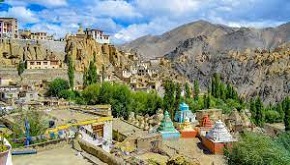
Ladakh was carved out of the erstwhile state of Jammu and Kashmir and made a Union Territory on 31st October 2019. In terms of area, Leh district is one of the two districts of Ladakh Himalayan region (Leh and Kargil). It is one of the remotest districts in India and has got land route connectivity only during summer. During winters, aerial connectivity is the only mode of mobility and transportation. In terms of climate, Leh is very harsh with prolonged winter and short summer with very short working season. The agricultural productivity is also limited and subsistence because of which most of the materials, be it consumable or non consumable, are procured from outside the district making the district even more vulnerable. Leh is a multi-hazard-prone district which makes it extremely vulnerable to natural disasters such as earthquake, cloudburst, floods, landslides, avalanches, wind storm, Cold wave, snow storm, drought, Locust menace beside man induced disasters such as war, chemical hazards, road accident, fire, conflict etc Leh district falls in the seismic Zone-IV (of Damage Risk Zone) as strike-slip fault runs along Zanskar and Ladakh ranges. With addition of the extreme climatic and geographical condition, makes it more vulnerable. The cold mountain desert has a fragile ecology that can support only a certain amount and type of development. Having the pressure and responsibility of emerging as one of the self-sustainable Union Territories, lot of modern infrastructural development is on the cards. In the name of development, lots of compromises viz-a-viz to environment and ecology have already been made during the last many years. In the last 10 to 15 years, the effects of climate change have become very visible— the devastating flash floods of 2010 and Glacier Lake Outburst Floods (GLOF) in villages like Domkhar, Achinathang, Gya etc being the prime examples. Hence, it would not be an exaggeration to say that the fast paced infrastructural and communication development has created a hole in the ecology of Ladakh. Ladakh falling in the seismic zone 4, earthquake could well be the most dangerous cause of disaster. Earthquakes measuring 5.4 and 4.9 on Richter scale have hit Leh on 25th and 27th of Sept. 2020 respectively. Considering the above factors, a need for proper planning to manage such extreme hazards to minimise the risk and also to get back to normalcy at the earliest possible will be very extremely crucial. The DDMP of Leh district aims to provide a useful framework for different departments and other agencies to define their roles and responsibilities for preparedness and response (in terms of risk mitigation, preparedness, search & rescue, relief, rehabilitation and reconstruction). The District Disaster Management Plan of Leh district has taken in to account the repercussions of all possible natural and manmade disasters. Measures for prevention and mitigation of various catastrophes are also elaborated in detail. A very elaborate and crisp information about Incident Response System of district is given in the plan as well. An attempt has been made to assess the capacity of various departments and the need for strengthening of capacity for disaster response is also incorporated. DDMP, Leh is based on an integrated approach of Institutional mechanism - roles and responsibilities of different departments and stakeholders including the Army, Air Force and Paramilitary Forces, private sector, and the local communities. Standard Operating Procedures (SOPs) during various stages of disaster is also explained succinctly in the plan. The District Disaster Management Plan (DDMP), Leh has been prepared as per template prescribed by the National Disaster Management Authority (NDMA). As Leh is standing at the intersection of modern development and climate change, it’s high time to pay special focus on District Disaster Management Plan (DDMP) so that the impact of modern development can be altered and mitigated in time; and, a holistic approach of sustainable development, as enshrined in the Leh Vision Document 2030, is adopted for the district.